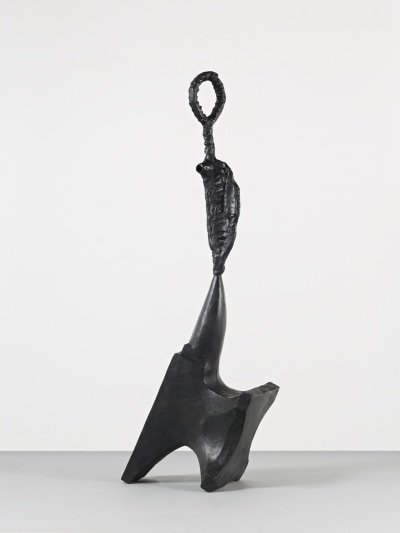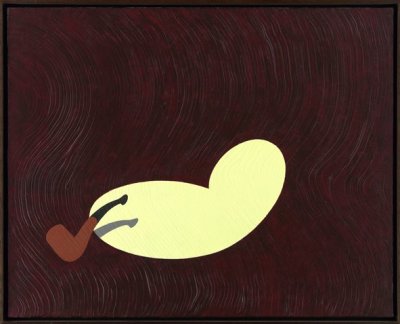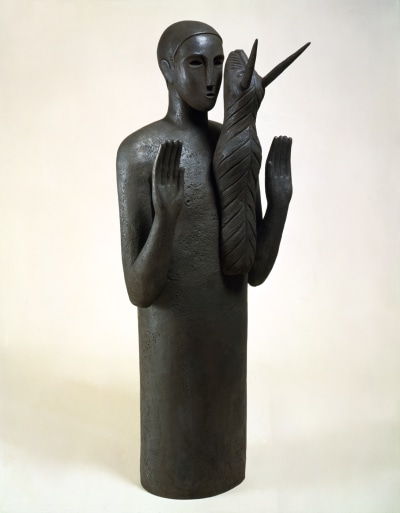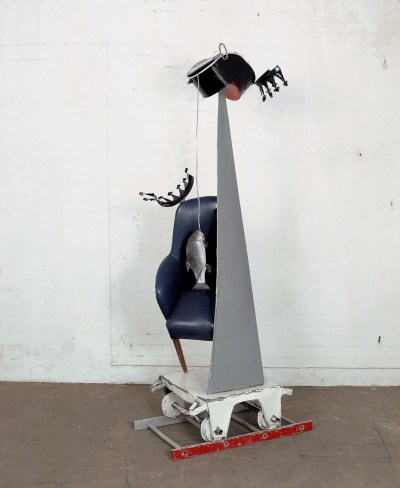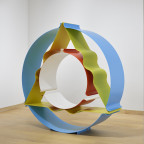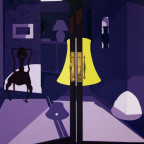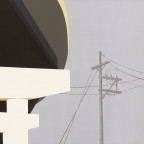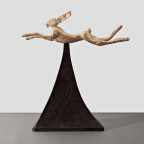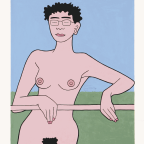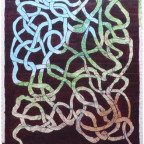Biography
"Illuminating" – Evening Standard
"Amazing...I could spend the whole entire broadcast talking about this show!"
– Louisa Buck for Talk Art
Filled with unexpected juxtapositions and clever visual puns, ‘Beyond Surrealism’ brings together works by a range of artists whose work shares Surrealist aesthetic strategies or conceptual concerns: Clive Barker, Patrick Caulfield, George Condo, Allan D’Arcangelo, Barry Flanagan, Mimmo Paladino, Lucas Samaras, John Wesley and Bill Woodrow among others. Anchoring each room in the exhibition are works by some of the key names connected to the first wave of Surrealism: Jean Arp, Giorgio De Chirico, Max Ernst and Joan Miró. These works delve into the recesses of the unconscious, challenge perceptions of reality, orchestrate metamorphosis and surprise, and conjure intricate, occasionally paradoxical, juxtapositions. Seen together they attest to the profound and far-reaching influence of Surrealism. The exhibition marks the 100th anniversary of the publication of the Surrealist Manifesto, written by poet André Breton in 1924.
Emerging as a transformative force from the avant-garde roots of Dada in the early 1920s, Surrealism evolved as one of the most influential artistic movements of the 20th century. Spreading internationally, it came to represent, above all, an art of juxtaposition and the coalescence of disparate elements with a witty or dreamlike logic. ‘La carmagnole’, a 1927 painting by Max Ernst (1891–1976) depicting an otherworldly scene populated by dancing, distorted figures, illustrates the Surrealists’ belief in metamorphosis and transformation. These fantastical elements are picked up by Lucas Samaras (1936–2024) in his Photofictions, a series of hallucinatory self-portraits and psychedelic compositions that conjure enigmatic scenes, while the amorphous sculptures of Barry Flanagan (1941–2009) blur the boundaries between human and animal, reality and fantasy. The bodily form and texture of Flanagan’s ‘The Voyager’, 1984, eerily echo the figures in Ernst’s painting.
Often employing symbols and hidden meanings, the work of the Surrealists articulated profound messages and emotions. Bill Woodrow’s (b.1948) unexpected combinations in ‘Half King, Whole Fish’, 1988 and ‘Clockswarm’, 2001 have the viewer scramble for concealed messages, while the playfully disturbing paintings of John Wesley (1928–2022) combine seemingly unrelated objects to create a sense of irrationality and surprise. An important reference point here is the relationship of image and object considered by René Magritte’s (1898–1867) painting ‘The Treachery of Images’, 1929, often referred to colloquially as ‘Ceci n’est pas une pipe’, today residing in the LACMA collection. Patrick Caulfield’s (1936–2005) great admiration for Magritte is revealed mostly clearly through ‘Night Pipe’, 1992, its titular subject matter a direct reference to Magritte’s masterpiece, and ‘Evening Paper’, 1999, which exemplifies the artists’ shared interest in the eeriness of empty interior spaces.
Giorgio de Chirico (1888–1978) also uses spatial dislocation to create mysterious scenes that prompt viewers to scrutinise the boundaries between reality and the imagination. ‘Piazza d’Italia’, 1960, a typically disquieting piazza painting, with classical arches, perspective and angled light, is paired with paintings by Allan D’Arcangelo (1930–1998) and Mimmo Paladino (b.1948). D’Arcangelo’s ‘Landscape with Three Trees’, 1968 defies conventional perspective and lighting, whilst Paladino’s enigmatic sculptures draw on mythology and architectural elements to resonate on a deep psychological level.
Jean (Hans) Arp (1886–1966) was interested in exploring the subconscious mind. He employed chance – arranging pre-cut biomorphic forms where they fell – to create ‘automatic collages’. These organic forms are echoed in the sculptures of Paul Feeley (1910–1966) and David Annesley (b.1936), who in the 1960s termed himself a ‘neo-Surrealist’, because for him ‘abstraction’ meant to abstract from the figure. The fluid, curvilinear forms that populate the paintings of Landon Metz (b.1985), made with a free-flowing dye that charts its own path, continue this Surrealist interest in automatism into the 21st century.
‘Beyond Surrealism’ affirms the enduring potency of Surrealism to kindle the imagination of the creative mind. While these artists did not term themselves Surrealist and could not be termed as such, this exhibition explores the ways in which the artistic practices they pursued were made in part possible by the Surrealist artists that came before them.
-
 Barry Flanagan, The Voyager, 1984
bronze
85 1/4 x 18 1/2 x 31 in / 216.5 x 47 x 78.5 cm
%3Cdiv%20class%3D%22artist%22%3E%3Cspan%20class%3D%22artist%22%3E%3Cstrong%3EBarry%20Flanagan%3C/strong%3E%3C/span%3E%3C/div%3E%0D%3Cdiv%20class%3D%22title%22%3E%3Cem%3EThe%20Voyager%3C/em%3E%2C%201984%3C/div%3E%0D%3Cdiv%20class%3D%22medium%22%3Ebronze%3C/div%3E%0D%3Cdiv%20class%3D%22dimensions%22%3E85%201/4%20x%2018%201/2%20x%2031%20in%20/%20216.5%20x%2047%20x%2078.5%20cm%3C/div%3E
Barry Flanagan, The Voyager, 1984
bronze
85 1/4 x 18 1/2 x 31 in / 216.5 x 47 x 78.5 cm
%3Cdiv%20class%3D%22artist%22%3E%3Cspan%20class%3D%22artist%22%3E%3Cstrong%3EBarry%20Flanagan%3C/strong%3E%3C/span%3E%3C/div%3E%0D%3Cdiv%20class%3D%22title%22%3E%3Cem%3EThe%20Voyager%3C/em%3E%2C%201984%3C/div%3E%0D%3Cdiv%20class%3D%22medium%22%3Ebronze%3C/div%3E%0D%3Cdiv%20class%3D%22dimensions%22%3E85%201/4%20x%2018%201/2%20x%2031%20in%20/%20216.5%20x%2047%20x%2078.5%20cm%3C/div%3E -
 Patrick Caulfield, Night Pipe, 1992
acrylic on canvas
24 x 30 in / 60.1 x 76.2 cm
Patrick Caulfield, Night Pipe, 1992
acrylic on canvas
24 x 30 in / 60.1 x 76.2 cm
-
 Mimmo Paladino, Testimone (figure with horned animal), 1997
bronze
66 1/8 x 22 7/8 x 21 5/8 in
168 x 58 x 55 cm
%3Cdiv%20class%3D%22artist%22%3E%3Cspan%20class%3D%22artist%22%3E%3Cstrong%3EMimmo%20Paladino%3C/strong%3E%3C/span%3E%3C/div%3E%0D%3Cdiv%20class%3D%22title%22%3E%3Cem%3ETestimone%20%28figure%20with%20horned%20animal%29%3C/em%3E%2C%201997%3C/div%3E%0D%3Cdiv%20class%3D%22medium%22%3Ebronze%3Cbr%20/%3E%0A%3C/div%3E%0D%3Cdiv%20class%3D%22dimensions%22%3E66%201/8%20x%2022%207/8%20x%2021%205/8%20in%20%3Cbr%20/%3E%0A168%20x%2058%20x%2055%20cm%3C/div%3E%0D%3Cdiv%20class%3D%22edition_details%22%3Ecopy%20number%201%20from%20an%20edition%20of%203%20plus%201%20AP%3C/div%3E
Mimmo Paladino, Testimone (figure with horned animal), 1997
bronze
66 1/8 x 22 7/8 x 21 5/8 in
168 x 58 x 55 cm
%3Cdiv%20class%3D%22artist%22%3E%3Cspan%20class%3D%22artist%22%3E%3Cstrong%3EMimmo%20Paladino%3C/strong%3E%3C/span%3E%3C/div%3E%0D%3Cdiv%20class%3D%22title%22%3E%3Cem%3ETestimone%20%28figure%20with%20horned%20animal%29%3C/em%3E%2C%201997%3C/div%3E%0D%3Cdiv%20class%3D%22medium%22%3Ebronze%3Cbr%20/%3E%0A%3C/div%3E%0D%3Cdiv%20class%3D%22dimensions%22%3E66%201/8%20x%2022%207/8%20x%2021%205/8%20in%20%3Cbr%20/%3E%0A168%20x%2058%20x%2055%20cm%3C/div%3E%0D%3Cdiv%20class%3D%22edition_details%22%3Ecopy%20number%201%20from%20an%20edition%20of%203%20plus%201%20AP%3C/div%3E -
 Lucas Samaras, Studio Workbench 2, 2003
Pure pigment on paper
34 x 44 in / 86.4 x 111.8 cm
%3Cdiv%20class%3D%22artist%22%3E%3Cspan%20class%3D%22artist%22%3E%3Cstrong%3ELucas%20Samaras%3C/strong%3E%3C/span%3E%3C/div%3E%0D%3Cdiv%20class%3D%22title%22%3E%3Cem%3EStudio%20Workbench%202%3C/em%3E%2C%202003%3C/div%3E%0D%3Cdiv%20class%3D%22medium%22%3EPure%20pigment%20on%20paper%3C/div%3E%0D%3Cdiv%20class%3D%22dimensions%22%3E34%20x%2044%20in%20/%2086.4%20x%20111.8%20cm%3C/div%3E
Lucas Samaras, Studio Workbench 2, 2003
Pure pigment on paper
34 x 44 in / 86.4 x 111.8 cm
%3Cdiv%20class%3D%22artist%22%3E%3Cspan%20class%3D%22artist%22%3E%3Cstrong%3ELucas%20Samaras%3C/strong%3E%3C/span%3E%3C/div%3E%0D%3Cdiv%20class%3D%22title%22%3E%3Cem%3EStudio%20Workbench%202%3C/em%3E%2C%202003%3C/div%3E%0D%3Cdiv%20class%3D%22medium%22%3EPure%20pigment%20on%20paper%3C/div%3E%0D%3Cdiv%20class%3D%22dimensions%22%3E34%20x%2044%20in%20/%2086.4%20x%20111.8%20cm%3C/div%3E -
 Bill Woodrow, Half King, Whole Fish, 1988
Car bonnet, steel locker, metal hat box, aluminium ladder, chair, enamel paint
87 x 55 x 30 3/4 in
221 x 140 x 78 cm
%3Cdiv%20class%3D%22artist%22%3E%3Cspan%20class%3D%22artist%22%3E%3Cstrong%3EBill%20Woodrow%3C/strong%3E%3C/span%3E%3C/div%3E%0D%3Cdiv%20class%3D%22title%22%3E%3Cem%3EHalf%20King%2C%20Whole%20Fish%3C/em%3E%2C%201988%3C/div%3E%0D%3Cdiv%20class%3D%22medium%22%3ECar%20bonnet%2C%20steel%20locker%2C%20metal%20hat%20box%2C%20aluminium%20ladder%2C%20chair%2C%20enamel%20paint%3Cbr%20/%3E%0A%3C/div%3E%0D%3Cdiv%20class%3D%22dimensions%22%3E87%20x%2055%20x%2030%203/4%20in%20%3Cbr%20/%3E%0A221%20x%20140%20x%2078%20cm%3C/div%3E
Bill Woodrow, Half King, Whole Fish, 1988
Car bonnet, steel locker, metal hat box, aluminium ladder, chair, enamel paint
87 x 55 x 30 3/4 in
221 x 140 x 78 cm
%3Cdiv%20class%3D%22artist%22%3E%3Cspan%20class%3D%22artist%22%3E%3Cstrong%3EBill%20Woodrow%3C/strong%3E%3C/span%3E%3C/div%3E%0D%3Cdiv%20class%3D%22title%22%3E%3Cem%3EHalf%20King%2C%20Whole%20Fish%3C/em%3E%2C%201988%3C/div%3E%0D%3Cdiv%20class%3D%22medium%22%3ECar%20bonnet%2C%20steel%20locker%2C%20metal%20hat%20box%2C%20aluminium%20ladder%2C%20chair%2C%20enamel%20paint%3Cbr%20/%3E%0A%3C/div%3E%0D%3Cdiv%20class%3D%22dimensions%22%3E87%20x%2055%20x%2030%203/4%20in%20%3Cbr%20/%3E%0A221%20x%20140%20x%2078%20cm%3C/div%3E -
 Jean Arp, Homme, moustache, nombril, 1927
ink and gouache on paper book cover
10 x 8 1/8 in
25.2 x 20.6 cm
%3Cdiv%20class%3D%22artist%22%3E%3Cspan%20class%3D%22artist%22%3E%3Cstrong%3EJean%20Arp%3C/strong%3E%3C/span%3E%3C/div%3E%0D%3Cdiv%20class%3D%22title%22%3E%3Cem%3EHomme%2C%20moustache%2C%20nombril%3C/em%3E%2C%201927%3C/div%3E%0D%3Cdiv%20class%3D%22medium%22%3Eink%20and%20gouache%20on%20paper%20book%20cover%3C/div%3E%0D%3Cdiv%20class%3D%22dimensions%22%3E10%20x%208%201/8%20in%20%3Cbr%20/%3E%0A25.2%20x%2020.6%20cm%3C/div%3E
Jean Arp, Homme, moustache, nombril, 1927
ink and gouache on paper book cover
10 x 8 1/8 in
25.2 x 20.6 cm
%3Cdiv%20class%3D%22artist%22%3E%3Cspan%20class%3D%22artist%22%3E%3Cstrong%3EJean%20Arp%3C/strong%3E%3C/span%3E%3C/div%3E%0D%3Cdiv%20class%3D%22title%22%3E%3Cem%3EHomme%2C%20moustache%2C%20nombril%3C/em%3E%2C%201927%3C/div%3E%0D%3Cdiv%20class%3D%22medium%22%3Eink%20and%20gouache%20on%20paper%20book%20cover%3C/div%3E%0D%3Cdiv%20class%3D%22dimensions%22%3E10%20x%208%201/8%20in%20%3Cbr%20/%3E%0A25.2%20x%2020.6%20cm%3C/div%3E -
 Max Ernst, La carmagnole, 1927
Oil on canvas
29 1/8 x 37 in
74 x 94 cm
%3Cdiv%20class%3D%22artist%22%3E%3Cspan%20class%3D%22artist%22%3E%3Cstrong%3EMax%20Ernst%3C/strong%3E%3C/span%3E%3C/div%3E%0D%3Cdiv%20class%3D%22title%22%3E%3Cem%3ELa%20carmagnole%3C/em%3E%2C%201927%3C/div%3E%0D%3Cdiv%20class%3D%22medium%22%3EOil%20on%20canvas%3C/div%3E%0D%3Cdiv%20class%3D%22dimensions%22%3E29%201/8%20x%2037%20in%20%3Cbr%20/%3E%0A74%20x%2094%20cm%3C/div%3E
Max Ernst, La carmagnole, 1927
Oil on canvas
29 1/8 x 37 in
74 x 94 cm
%3Cdiv%20class%3D%22artist%22%3E%3Cspan%20class%3D%22artist%22%3E%3Cstrong%3EMax%20Ernst%3C/strong%3E%3C/span%3E%3C/div%3E%0D%3Cdiv%20class%3D%22title%22%3E%3Cem%3ELa%20carmagnole%3C/em%3E%2C%201927%3C/div%3E%0D%3Cdiv%20class%3D%22medium%22%3EOil%20on%20canvas%3C/div%3E%0D%3Cdiv%20class%3D%22dimensions%22%3E29%201/8%20x%2037%20in%20%3Cbr%20/%3E%0A74%20x%2094%20cm%3C/div%3E






